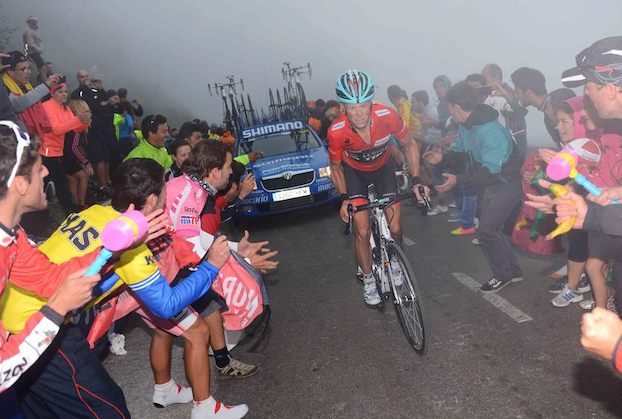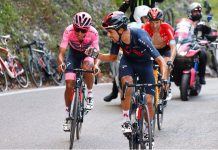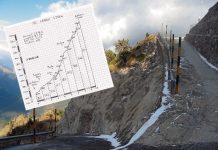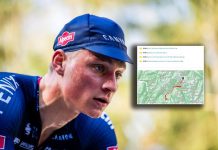One climb is more feared than any other: The Alto de l’Angliru. A name that sends a chill down the spine of even the leanest and meanest of mountain goats.
The excessively steep Angliru has produced some huge dramas since its first inclusion in 1999 and it is only natural that the organizers have been tempted to make again the race tough for the riders.
The first 6km are fairly “easy” with a rather constant 8-9% gradient but from there hell breaks loose. During the next 4km, the gradient will stay above 12% and the climb has some excessively steep parts with the gradient reaching its peak at 23,5% 2km from the finish.
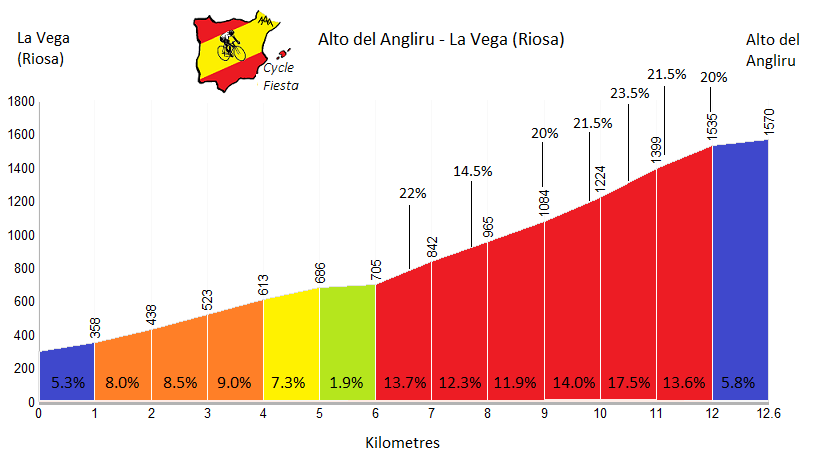
The climb gets a little easier towards the finish where it has a 10% gradient but a 21% ramp just 1km from the finish will still make for a torturous final. On such a steep climb, it is every man for himself and the GC can potentially be turned upside down.
There are several hairpin bends inside the final 5km of the stage and the final one is located just before the flamme rouge. From there, there is one sharp turn and a number of sweeping corners. The final one leads onto the 500m finishing straight.
The climb debuted in 1999 when climber Jose Maria Jimenez beat Pavel Tonkov in a sprint at the top while Gilbert Simoni crushed the opposition one year later, finishing more than 2 minutes ahead of his nearest rival. Roberto Heras put 1.35 into Joseba Beloki in 2002 which preceded a long absence for the Asturian climb. It made a comeback in 2008 when Alberto Contador beat Alejandro Valverde and Joaquim Rodriguez.
In 2011, Juan Jose Cobo laid the foundations for his overall win by taking a dominant solo victory while Chris Froome was finally allowed to leave his struggling team captain and race leader Bradley Wiggins behind.
The most recent appearance of the Angliru in the Vuelta came in 2017. An aging Alberto Contador capitalized and took his second victory on the brutal climb. With the help of teammate Jarlinson Pantano, Contador started the climb with a buffer of roughly 30 seconds on the overall contenders. Contador bridged up to the front of the race before going solo with 5.5 km to go.
Contador held on to win by 17 seconds ahead of Wout Poels and Chris Froome. In doing so, he secured the final victory of his storied career. Contador also earned the honor of becoming the first man to win on the Angliru twice.
Past results suggest that it’s plausible that victory on the Angliru could be claimed either by a breakaway or a GC contender. Based on the style of racing that was on display during today’s stage to Alto de la Farrapona, a victory by a GC contender seems more likely.
The favorites were content to keep their powder dry in anticipation of fireworks on the Angliru. Therefore, they will be motivated for a big showdown tomorrow. David Gaudu took advantage of that strategy to grab the stage win ahead of Marc Soler from the breakaway, while the GC guys waited until the final few hundred meters to show themselves.
Richard Carapaz and Primoz Roglic have proved to be the two strongest GC riders in the race up until this point. The two men are currently sitting even atop the overall standings. Carapaz needs to gain time on Roglic ahead of the stage 13 time trial. That being said, the strength of Roglic’s team makes Carapaz’s job a lot harder. Both Sepp Kuss and George Bennett were present to assist Roglic while Carapaz was isolated in the finish of Saturday’s stage. That disparity should only be magnified by the difficulty of the Angliru.


